 The Riddler, the Penguin, Catwoman and the Joker hijack Gotham’s most-watched TV variety show simply to signal their latest crime wave. Batman and Robin follow leads and pursue the criminals, but Catwoman thinks she knows how to sway Batman to their side, using a potent chemical concoction that will do away with Batman’s urge to do good. The chemical doesn’t work until after Batman has rounded up the quartet of criminals, but when its effects do kick in, Batman suddenly installs himself as the ruler of Gotham City, relieving the police of their duties and allowing anarchy to reign. Alfred is fired, and Aunt Harriet is sent away in tears. Robin is about to go it alone against his mentor when he decides to enlist Catwoman’s reluctant help instead. But how can Robin fight the man who taught him everything he knows about fighting crime?
The Riddler, the Penguin, Catwoman and the Joker hijack Gotham’s most-watched TV variety show simply to signal their latest crime wave. Batman and Robin follow leads and pursue the criminals, but Catwoman thinks she knows how to sway Batman to their side, using a potent chemical concoction that will do away with Batman’s urge to do good. The chemical doesn’t work until after Batman has rounded up the quartet of criminals, but when its effects do kick in, Batman suddenly installs himself as the ruler of Gotham City, relieving the police of their duties and allowing anarchy to reign. Alfred is fired, and Aunt Harriet is sent away in tears. Robin is about to go it alone against his mentor when he decides to enlist Catwoman’s reluctant help instead. But how can Robin fight the man who taught him everything he knows about fighting crime?
written by Michael Jelenic & James Tucker
directed by Rick Morales
music by Kristopher Carter, Michael McCuistion and Lolita Ritmanis / Batman theme by Neal Hefti
Cast: Adam West (Batman), Burt Ward (Robin), Julie Newmar (Catwoman), Jeff Bergman (Announcer / Joker), Sirena Irwin (Miranda Moore), Thomas Lennon (Chief O’Hara), William Salyers (The Penguin), Lynne Marie Stewart (Aunt Harriet), Jim Ward (Commissioner Gordon), Steven Weber (Alfred), Wally Wingert (The Riddler)
LogBook entry & review by Earl Green
Review: For years, I’ve railed against “received wisdom” in fandom. I’ve gone off against perpetuators of received wisdom many a time – the Star Trek fans who think there’s nothing redeeming about 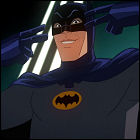 Spock’s Brain, the Star Wars fans who make it sound as though the prequel trilogy is the worst thing ever, Doctor Who fans who pile onto the episode Love & Monsters, or Atari afficionados who blindly hold to the notion that E.T. was the weakest game on the 2600. There’s a difference between something being the worst and something simply not being your cup of tea, and sometimes you just have to experience something for yourself to determine which is closer to the truth.
Spock’s Brain, the Star Wars fans who make it sound as though the prequel trilogy is the worst thing ever, Doctor Who fans who pile onto the episode Love & Monsters, or Atari afficionados who blindly hold to the notion that E.T. was the weakest game on the 2600. There’s a difference between something being the worst and something simply not being your cup of tea, and sometimes you just have to experience something for yourself to determine which is closer to the truth.
Even though it’s mere hours old where public consumption is concerned as I write this, I think the animated Batman feature Return Of The Caped Crusaders is itself a victim of just that kind of received wisdom.
I jumped out of my seat and punched the air when it was announced that Adam West, Burt Ward and Julie Newmar had recreated their roles from the 1960s live-action Batman TV series in a recording studio; I wasn’t sure 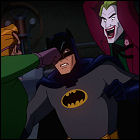 what to expect, but I was definitely looking forward to it. From a production and performance standpoint, there’s little to fault here – the animation is gorgeous, and the cast is wonderful, even where beloved actors have had to be replaced by voice artists doing their best sound-alikes. I was a little disappointed that Mark Hamill wasn’t the Joker for this outing, but as I listened to Jeff Bergman playing the part, I realized that any attempt to revive Cesar Romero’s interpretation of the Joker needed a different kind of energy. The actors doing their best to recreate the voices of Frank Gorshin and Burgess Meredith won me over pretty quickly. The music – by the same composers who have been accompanying Batman since his ’90s animated heyday – gets that Neal Hefti/Nelson Riddle vibe and then builds it up even bigger. Our first glimpse of the Batmobile rotates around the vehicle for more than a complete 360-degree circle before our heroes climb into it, and I instantly recognized that as the animated equivalent of Star Trek: The Motion Picture‘s lovingly lingering Enterprise drydock montage. I grew up watching Batman in
what to expect, but I was definitely looking forward to it. From a production and performance standpoint, there’s little to fault here – the animation is gorgeous, and the cast is wonderful, even where beloved actors have had to be replaced by voice artists doing their best sound-alikes. I was a little disappointed that Mark Hamill wasn’t the Joker for this outing, but as I listened to Jeff Bergman playing the part, I realized that any attempt to revive Cesar Romero’s interpretation of the Joker needed a different kind of energy. The actors doing their best to recreate the voices of Frank Gorshin and Burgess Meredith won me over pretty quickly. The music – by the same composers who have been accompanying Batman since his ’90s animated heyday – gets that Neal Hefti/Nelson Riddle vibe and then builds it up even bigger. Our first glimpse of the Batmobile rotates around the vehicle for more than a complete 360-degree circle before our heroes climb into it, and I instantly recognized that as the animated equivalent of Star Trek: The Motion Picture‘s lovingly lingering Enterprise drydock montage. I grew up watching Batman in 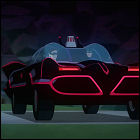 syndication at my grandmother’s house after elementary school, wolfing down her delicious-but-none-too-good-for-me grilled cheese sandwiches and washing those down with Dr. Pepper. The Batmobile was my first car “love”. I appreciated the lingering look at it.
syndication at my grandmother’s house after elementary school, wolfing down her delicious-but-none-too-good-for-me grilled cheese sandwiches and washing those down with Dr. Pepper. The Batmobile was my first car “love”. I appreciated the lingering look at it.
What does any of this have to do with received fannish wisdom? I’m about to get to that part. All of my problems with Return Of The Caped Crusaders lie within the script. There are places where the scripts gets it so right – i.e. Bruce Wayne and Dick Grayson mysteriously “going fishing” at the most bizarre times to cover their secret lives of crime(fighting), or the arch-villains’ respective styles of quipping and ranting – but when the script gets it wrong, it gets it so wrong that I found myself wondering: have these guys actually watched the original 1966 iteration of Adam West’s Batman, or have they simply heard about it? Because yes, the TV series was steeped in camp, but the beauty (and part of the humor) of it 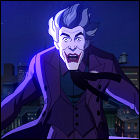 was that its two leading men, along with everyone who wasn’t a villain, played it deadly earnest. So: Robin complaining that ballet practice has left his legs too weak to climb the side of a building (as he and Batman are wont to do) = fits perfectly, while Batman bringing everything to a screeching halt to lecture Robin on the importance of using the crosswalk = a bit of a stretch. Return Of The Caped Crusaders can’t decide if it’s affectionately recalling the original show’s excesses, or lampooning them in full satire mode.
was that its two leading men, along with everyone who wasn’t a villain, played it deadly earnest. So: Robin complaining that ballet practice has left his legs too weak to climb the side of a building (as he and Batman are wont to do) = fits perfectly, while Batman bringing everything to a screeching halt to lecture Robin on the importance of using the crosswalk = a bit of a stretch. Return Of The Caped Crusaders can’t decide if it’s affectionately recalling the original show’s excesses, or lampooning them in full satire mode.
Some of the movie’s best moments are when it exceeds the parameters of its inspiration: as Batman starts to lose control and really starts beating up the bad guys, the shift in tone is noticeable and significant. The Batrocket is goofy, but fits in with the space race millieu of the sixties. The meta gag 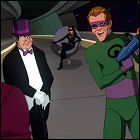 in which Batman sees all three versions of Catwoman was just under-the-radar enough to work. Where things go too far is in Batman and Robin’s goofy duel of utility belt gadgets, culminating with Robin saving Catwoman with an “anti-isotope spray” – a gag which is no longer concerned with suspension of disbelief, but rather making a comment on the original show’s excesses (which were never, ironically, as excessive as this scene commenting on them). Or the cameras in the TV studio with a “fight scene” setting that tilts them down to a Dutch angle. Or Aunt Harriet hinting that Bruce and Dick might be gay. Some of these gags seemed as if they were devised by someone who has heard about how goofy the original show was, without having experienced it for themselves to figure out what the show’s actual stylistic parameters were…thus, the collectively exaggerated, misremembered elements of the live-action show become the new reality for the revival. Which is frustrating, because some of the callbacks, such as the Catwoman gag, or the appearances of many of the TV series’ villains in the final fight (including Egghead, Mr. Freeze and King Tut), speak to a deeper knowledge and appreciation of the original show than some of the other gags let on.
in which Batman sees all three versions of Catwoman was just under-the-radar enough to work. Where things go too far is in Batman and Robin’s goofy duel of utility belt gadgets, culminating with Robin saving Catwoman with an “anti-isotope spray” – a gag which is no longer concerned with suspension of disbelief, but rather making a comment on the original show’s excesses (which were never, ironically, as excessive as this scene commenting on them). Or the cameras in the TV studio with a “fight scene” setting that tilts them down to a Dutch angle. Or Aunt Harriet hinting that Bruce and Dick might be gay. Some of these gags seemed as if they were devised by someone who has heard about how goofy the original show was, without having experienced it for themselves to figure out what the show’s actual stylistic parameters were…thus, the collectively exaggerated, misremembered elements of the live-action show become the new reality for the revival. Which is frustrating, because some of the callbacks, such as the Catwoman gag, or the appearances of many of the TV series’ villains in the final fight (including Egghead, Mr. Freeze and King Tut), speak to a deeper knowledge and appreciation of the original show than some of the other gags let on.
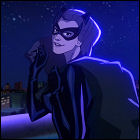 Or maybe I’m taking it all too seriously. It’s good fun regardless, and apparently a sequel is already on the way, with William Shatner as Two-Face – a piece of dream casting if there ever was one, as I always wondered why they had never shared the screen together – so I’m willing to give this format another chance. It’s not as if the 1966 TV Batman was high art that needs to be held sacrosanct, but it did have a playbook of sorts for its highly stylized world, and Return Of The Caped Crusaders plays fast and loose with that. For every nicely constructed gag, there’s a gag – usually of a “meta” nature – that knocks down the fourth wall with an exploding batarang. The original show didn’t have many uncrossable boundaries, but it did have them – and Return Of The Caped Crusaders crosses enough of them that, in spite of enjoying it all, I was still thinking “No, that’s not quite right.”
Or maybe I’m taking it all too seriously. It’s good fun regardless, and apparently a sequel is already on the way, with William Shatner as Two-Face – a piece of dream casting if there ever was one, as I always wondered why they had never shared the screen together – so I’m willing to give this format another chance. It’s not as if the 1966 TV Batman was high art that needs to be held sacrosanct, but it did have a playbook of sorts for its highly stylized world, and Return Of The Caped Crusaders plays fast and loose with that. For every nicely constructed gag, there’s a gag – usually of a “meta” nature – that knocks down the fourth wall with an exploding batarang. The original show didn’t have many uncrossable boundaries, but it did have them – and Return Of The Caped Crusaders crosses enough of them that, in spite of enjoying it all, I was still thinking “No, that’s not quite right.”
